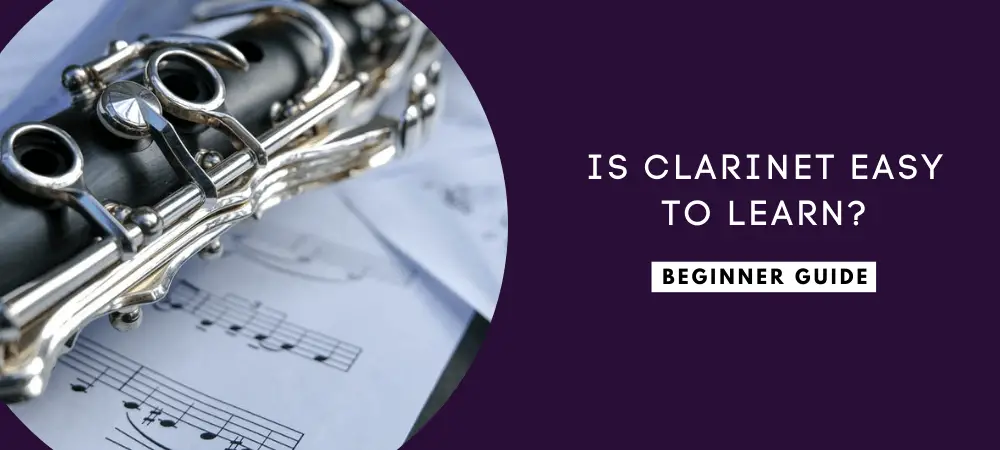Wind instruments are fun to learn. And the Clarinet is one of them.
But for most beginners, it’s the fear of the unknown that holds them back from enrolling in musical classes.
Some are even scared to invest adequately, not knowing how long they can withstand the pressure of not being able to play good tunes.
But is the Clarinet hard to learn as some say? Or is it actually easier than people think?
This article seeks to expound more on this. Read on!
Table of Contents
Why I think Clarinet is Easy to Learn
1) Easy for Beginners to Master
If you’re planning on learning a woodwind instrument, but don’t know where to begin, I would highly recommend that you start with the Clarinet. Why?
Because, this is one of the easiest woodwind instruments to master, especially for beginners.
Most advanced players recognize how hard it’s even for them to get the correct tuning and the various dynamics that the instrument presents.
However, for a beginner who plays within the two-octave range, the Clarinet overlooks a lot of mistakes.
So, you can make a flimsy blow, get your jaws tired, or your inexperienced fingers might not cover the tone holes correctly, but you will still produce a decent sound.
Well, safe from the occasional screak, which might embarrass you. But that shouldn’t discourage you as most clarinet players go through this from time to time.
Also, as you dedicate your energy to learning the instrument, you will realize that it’s pretty easy to get your instrument to produce a natural range tune by simply adjusting the barrel.
And this shouldn’t be difficult to do.
Another thing, the Clarinet, makes it easy to finger. And that’s probably why most beginners find it easy to remember.
If one is attentive, they will within no time connect notes to various fingerings, which is made easier by the single melodic line present.
2) The Clarinet Offers Versatility
Although the Clarinet is commonly known to be used in classical reserve and various marching bands, other players want to learn it for other reasons. It does a lot of things.
Today, you can easily spot it in jazz bands, orchestras, and much more.
This could be because this instrument produces well-balanced tones, which aren’t too high or too low.
And the fact that you can’t compare it to the complexity of high-pitched woodwind instruments such as the flute makes the Clarinet easy to learn.
For this reason, the Clarinet is also popular and enjoys good prestige.
3) Gender Neutral
If you have been following the history and discussions on various wind instruments, then you must be aware that some are considered masculine and others feminine.
For instance, even in recent years and also presently, the flute is considered un-masculine in various parts of the world. And the lower-brass instruments, such as the alto horn, tuba, and trombone, are categorized as un-feminine.
But, when it comes to the Clarinet, everybody seems to like it. And to me, that means everyone can comfortably play it if they want to.
Therefore, if you attend a clarinet class today, you are not only going to meet beginners but also advanced players who want to get better at it.
And this, in a way, helps a pudding player to feel less self-conscious, do their best and learn faster than expected.
4) Transitions Well Into the Saxophone
It’s popularly said that if you’ve played any wind instrument before, then it shouldn’t be hard to try out other varieties.
In this case, I can confidently say that if you learn how to play the Clarinet first, then it will be much easier for you to switch to the saxophone.
This is because both instruments share a lot of similarities.
Therefore, if this doesn’t make the Clarinet easier to play, then I don’t know what would!
Skills you Need to Learn to Play Clarinet
You see those renowned clarinet players you admire so much, they too were once beginners.
What differentiates them from the other struggling players is how much skills they were willing to acquire to get better at it.
So, if you want to learn to play the Clarinet, then you should also begin by learning some essential skills, such as:
Producing Within Range Tones
This is probably where you should begin. First, you should focus on mastering the art of tone production. That, too, within the specified range of the instrument you’re using.
And this typically refers to the ability to correctly read the score and efficiently converting it into likeable music.
Start learning how to hold tones for the correct time-length correctly, and then maintaining the consistent tempo. Music ought to be played as it’s written.
Ability to Alternate Fingers
For beginners, learning the concept of alternate fingerings is easier said than done. And that refers to fingerings such as Eb to C and C to Eb.
But that shouldn’t discourage you from trying. Remember, once you master this, you can easily transition. And that’s an essential part of becoming a great clarinet player.
Instrument Appreciation
Yes, I know what you must be thinking! That this isn’t a skill, perhaps? Or it’s too simple to be considered a skill?
The fact remains that you can’t be motivated to continuously learn an instrument if you don’t know it that well. This happens in every relationship.
You would want to know whom you’re dealing with, to appreciate them the way they’re, right? The same case applies to your instrument.
Aspire to learn as much as possible about the Clarinet. Know its various parts, their importance. And that refers to the most crucial to the least.
Find out about its inventor. What inspired them to come up with it and what kind of music they enjoyed playing.
Learn about its evolution to the current times. Studying creates curiosity and excitement. And you will need much of this to master the instrument quickly as a beginner.
Remember, inspiration comes from in different ways.
Repeated Practice
This mainly applies to younger players. Most of them think that everything will flow into place within the first practice session, and they end up disappointed.
And because of this, it’s easy to give up, especially on complex pieces. But that shouldn’t be the case.
Instead, learn to practice repeatedly. It might be difficult at first and might seem like a waste of time, but with patience and persistence, you will concur with even the toughest musical pieces.
If you don’t believe me, ask around. Most experienced clarinet players will tell you that it took them more than 100 sessions to master their first recital piece.
Actually, there’s a level of mastery that only good practice and some helpful coaching will help you achieve.
If you do everything right, then you will always enjoy playing your instrument.
Tips to Start Learning Clarinet the Right Way
a) Blow it Harder
The most common problem among beginner clarinet players is that they don’t get to use sufficient air in their training sessions.
Most of them hold back, while others are scared of blowing wrongly.
But, those assumptions are all in your mind. The best thing to do is to loosen up and blow that instrument hard.
Remember, even with its small size, your instrument requires a sufficient amount of air to produce smooth and clear tones.
You can begin by practicing breathing in exercises.
Here, your focus should be to fill your lungs with every breath and then using those abdominal muscles to push out the air, straight into the instrument forcefully.
b) Be Comfortable Around the Mouthpiece
The best way to learn the Clarinet, is not being scared of the mouthpiece.
Remember, this is a crucial part of your instrument, so you should always place your mouth against it correctly.
And although it’s normal for most beginners to be a little bit hesitant, probably because of their inexperience, it’s important to place your mouth close enough on the embouchure.
Once you do, it will be easy to find out the best opposition for you and adjust accordingly, according to your musical style.
Simply ensure your top teeth are well placed about ½ inch from the tip of the mouthpiece and work on improving your mouth technique.
And hey! Don’t bite that reed too hard!
c) Achieve a Good Holding Position
It will be impossible to correctly play your instrument if you don’t hold it properly.
Therefore, first, give it a tight hold with your hands. And by this, I don’t mean holding your Clarinet as if you want to beak it!
No, the touch shouldn’t be too tight or too loose. Achieve a balance such that you can comfortably play it without dropping it. Get it?
The best way to achieve this is by applying the “C” hand position. You should see a clear wide “C” curve between your thumb and index finger
d) Give Your Clarinet a Right Angle Hold
When you get to blow your instrument, the sound shouldn’t be too loud, or even squeaky.
Instead, it should come out smooth and crispy clear. So, if you don’t like the tone you produce, then something must be a mess somewhere.
The best way to achieve this is by holding your instrument a 45-degrees hold from your body.
And this also includes practicing a good posture during your performance. If you aren’t standing, then ensure you’re sitting upright.
This way, the lungs won’t be squeezed to compress the airwaves. But even with this, ensure you’re comfortable. You won’t enjoy the performance if you’re too stiff.
Checkout this video on the easiest way to sound better on the Clarinet:
Best Courses to Learn Clarinet Online
Whether you’re aspiring to learn the Clarinet as a profession or for fun purposes, you should also be ready to invest your resources in it.
And by this, I mean both time and money.
You will have to keep practicing, and sometimes you have to take a course or two to perfect your art.
If you can’t find a physical class within your location, you will be glad to know that there are various online courses, such as the ones below, you can use.
Most of them are free!
The Udemy website is one of the highly ranked online resources for on-demand courses on various topics.
And unlike other sources where the quality decreases with quantity, with this website, each course enjoys specialized attention, maintaining the quality of services you receive.
Therefore, you can expect the same with the clarinet courses offered on this great website.
The courses come in various packages with different pricing. So, you choose what best suits your needs.
For example, there is a course meant for beginners, another for intermediates, and even a series to take you through the beginner stage, right to the professional level. That too, in a matter of hours, days, weeks or even months.
The best part of this website is that it’s run by Michelle Anderson. She has been tutoring Clarinet and has been performing for 30+ years. So, you can already imagine the quality of the services you will receive.
Michelle is good with both adults and children, which is a plus, especially when not everyone can perfectly handle kids.
The website is easy to peruse through and is accommodating not only for individuals who want to learn advanced clarinet skills but also for basic learners and players interested in a specific song(s).
And if you’re on-budget, you get to enjoy a massive collection of Michelle’s free clarinet courses.
The learning model offers a lot of flexibility, and it also covers a wide range of styles. So, whether you’re a beginner or an advanced player, you will find great resources here.
This Ricardo Morales course is great for both beginners and advanced players.
The only disadvantage, however, is that you will have to pay for it, but according to the numerous positive reviews online, you will receive value for your money.
This course will take you through the various clarinet basics before you decide whether to advance or not.
Also, the fact that Ricardo is a principal player for the Philadelphia Orchestra means that you will be learning from the best, especially if you want to perform in bands and orchestras.
If you don’t mind holding Clarinet online lessons via Skype, then this website is your ideal pick.
It teaches these important skills to everyone interested in learning Clarinet from all parts of the world.
So, when you sign-up, you will automatically be paired with a highly-skilled tutor, who will do their best to help you achieve your goals.
The lessons are live over Skype, meaning you get to interact one-on-one with your teacher, ask questions and even develop a personal mentor relation, which is helpful in career growth.
And the best part is that the website allows their students to rent or buy their instruments, which could give you an advantage over your peers.
The course isn’t free and is divided into a 3-months, 6 months and 12 months plan.
Nowadays, you can easily find any service in Fiverr.
For those who don’t know, this is an online marketplace with freelancers from across the globe. They all come to offer various services to clients.
So, it won’t be impossible to find qualified clarinet tutors on this site.
The best part is that these freelancers offer such services for as little as $5. Therefore, even if you’re on a budget, you will at least learn substantial skills to help you define your musical path.
You also stand to get discounts, where possible.
Their payment system cushions both buyers and sellers, so there is less possibility of getting scammed.
And signing up is free.
FAQs About Is Clarinet Easy to Learn
Is Clarinet or Flute Easier to Play?
As a beginner, learning to play the Clarinet or flute isn’t any easier or harder as compared to playing other orchestra instruments within the same range.
The hardest part of playing this instrument is mastering how to get a good sound out of it in your first training session.
But once you understand you to place your mouth on the mouthpiece properly, you can now start to learn everything else.
Therefore, how fast you learn from one note to the next largely depends on your capability as an individual.
That said, the Clarinet is generally considered easier to learn than the flute, mainly because it takes a little bit more practice to learn how to hold the flute correctly.
Also, producing a good tone using the flute isn’t as easy as when using a clarinet, which used a single reed.
Which is the Best Clarinet for Beginners?
In our previous article on the best student clarinets, we ranked the Jean Paul USA Student Clarinet Plus CL-350, as the best overall. Followed by Yamaha YCL-255 Standard Bb Clarinet, and Mendini by Cecilio B Flat Beginner Student Clarinet, among others.
Read the article for more information.
And while at it, don’t forget to check out the best clarinet mouthpieces article as well.
What does BB Mean, Clarinet?
This refers to a B-flat clarinet instrument, which is popularly used in orchestras. It comes with a small key on its back, and it’s a transposing instrument.
This generally means, you will always hear the major second note first, which is just below the one indicated on the music page.
How Many Notes Are on a Clarinet?
The Clarinet has 19 notes, complete with an E to Bb, and a chromatic octave.
Watch this video for more insights:
Is Playing the Clarinet Bad for Your Teeth?
A clarinet is a wind instrument, and playing it doesn’t interfere with the interior positioning of your teeth.
But, if you use a bigger mouthpiece, then it could affect the alignment of your lower teeth.
Conclusion
From the above insights, it’s clear that neither is the clarinet too easy to play or too hard to learn.
Instead, like any other wind instrument, you’ve to learn the crucial skills and equip yourself with useful tips (such as the ones above), to enable you to learn faster and be a pro among your peers.
We, therefore, hope this article will be helpful to you and your loved ones. And if there’s anything we forgot to mention, feel free to share with us in the comment section.




